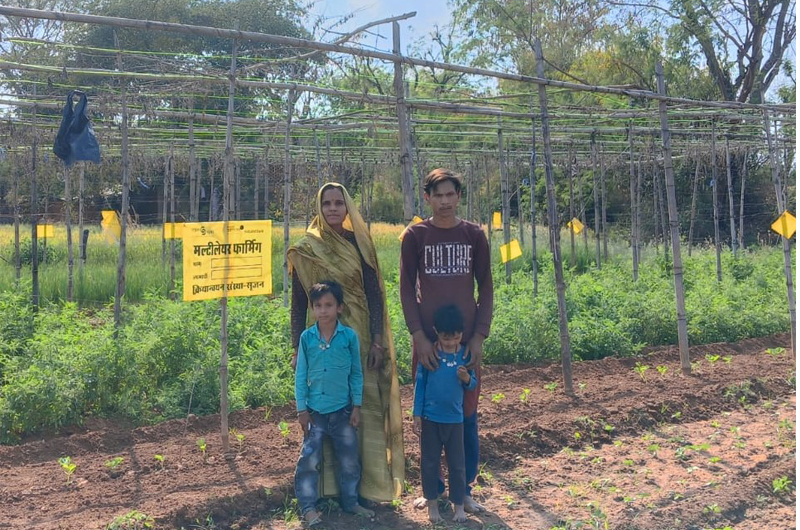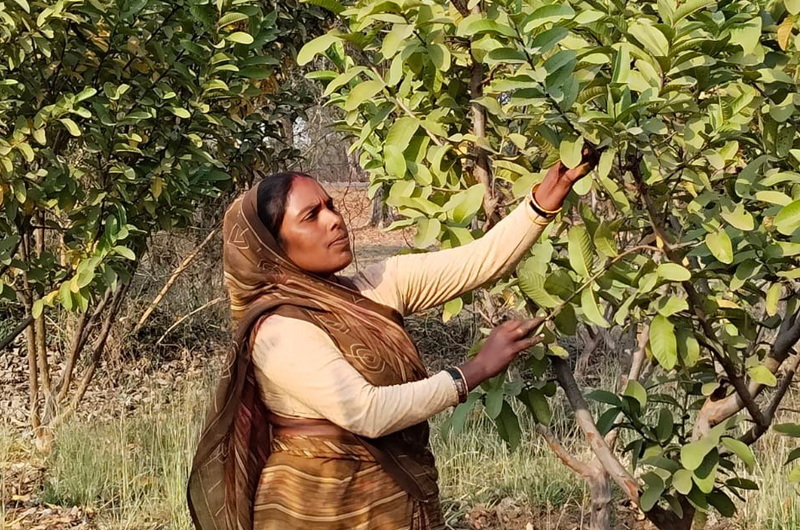Bharat Dogra talks to women who have been growing fruit trees using natural farming methods on their small landholdings, boosting their family’s health and reviving the soil
Promoting very small orchards and vegetable gardens in villages to benefit the weaker and vulnerable sections in several parts of India, particularly women, is an important component of the work taken up by SRIJAN (Self-Reliant Initiatives through Joint Action), a voluntary organisation. A recent visit to one such region in Shivpuri District of Madhya Pradesh revealed increasing hope and enthusiasm among the villagers, as the orchards start yielding fruits and diverse vegetables for home use and also for sale.
Pooja and Umesh grow about 15 kinds of vegetables in a year in a multi-layer garden that includes creepers and root crops, to optimise their small plot of land, while continuing to cultivate regular crops such as wheat and groundnuts. They take pride and joy in the fact that the vegetables they grow taste better than what they were getting from the market. The family’s nutrition profile has improved significantly and there is regular cash coming in from the sale of vegetables, they say.
In Umrikhurd Village, a group of women are delighted to speak about their small orchards of guava trees. One difficulty is that there can be no harvest and, hence, no income for the first two years, but they have ingeniously intercropped the young guava plants with some legume crops which also help the orchard flourish as they fix nitrogen in the soil. Rajkumari says she earned Rs 5,000 from selling the peas she grew, besides using a lot of the crop for home consumption. Rachna earned Rs 3,500, and other women benefitted too. These women are also simultaneously getting familiar with natural farming methods.
In Sirsod Village, Rashmi Lodhi is already harvesting fruit from her guava orchard. She has also added a few lemon and jackfruit trees. In fact, several villagers prefer mixed orchards, as this increases diversity and reduces risks. Rashmi, too, had practised intercropping in the early years of the orchard, but now, with the trees having become full-grown, this is no longer needed.
Rashmi’s orchard is an example of the success of combining the efforts of the government and voluntary organisations. Her family was able to get wages as well as recover the cost of plants under a government scheme, while SRIJAN provided technical and other support. SRIJAN continues to support villagers more directly in many cases, with the backing of organisations like the IndusInd Bank.

small plot of land, while continuing to cultivate regular crops such as wheat and groundnuts. They are seen here with their children.
Badami, whose landholding is nearby, has nearly 60 guava trees despite the small size of her plot. “We ate a lot of fruit, gifted some to our relatives and also earned some cash,” she says. She is now thinking of adding some mango trees to the orchard. These villagers were not able to afford to buy much fruit earlier, and the regular addition of fruits to their diet has certainly improved nutrition.
As members of a farmer-producer company, the women are also likely to benefit from processing and value-addition initiatives in the future, which can boost their earnings. With the adoption of natural farming methods, the health of their families as well as of the soil will improve too, besides reducing costs. Bio-resource centres that make available organic fertilisers and pest-repellants are being set up in several of these villages, further increasing the possibilities of the spread of natural farming. These efforts contribute both to climate change mitigation and adaptation.
(The writer is a senior freelance journalist and author who has been associated with several social movements and initiatives. He lives in New Delhi.)



 from Webdoux
from Webdoux